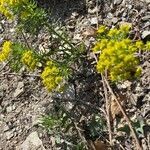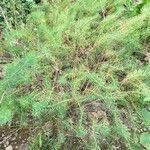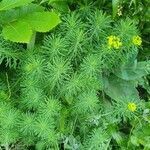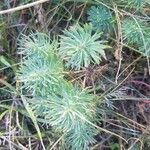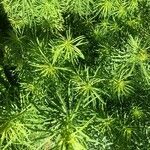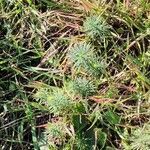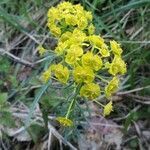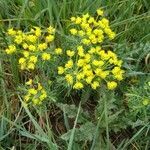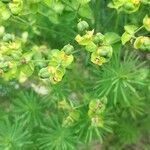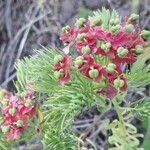Glabrous, rhizomatous, herbaceous perennial. Stems somewhat woody toward base, up to 50 cm high, branched or not at base, usually with some non-flowering branches. Lvs alternate, exstipulate, sessile, entire, linear, acute, (5)-10-20-(25) mm long. Terminal umbel with numerous rays, usually a few axillary rays arising below; lvs subtending rays like stem lvs, somewhat broadened at base; rays sometimes secondarily branched but usually forming a simple or once-compound dichasium; lvs subtending ray-branches and cyathia reniform to suborbicular, not connate, yellowish or becoming reddish. Glands elliptic; horns very short, slender. Capsule smooth, slightly granulate on rounded keels. Seeds smooth, rounded, grey, 1.5-1.75 mm long.
Colonial by rhizomes, loosely erect, 1.5–3(–4) dm; cauline lvs very numerous, crowded, linear, 1–3 cm × 1–3 mm, 1-nerved, those subtending the umbel similar, those of the umbel broadly cordate; rays of the umbel usually 10 or more; fr 3 mm, seldom produced, slightly granular-roughened; seeds plump, smooth, 1.5–2 mm; 2n=20, 40. Native of Eurasia, commonly established in our range in roadsides, waste ground, and cemeteries; Me. to Wash., s. to Va. and Ark. Apr.–July. (Tithymalus c.; Galarhoeus c.)
A short hairless herb. It grows 30 cm tall. It has rhizomes and keeps growing from year to year. It often forms tufts. The stems usually branch from the base. The leaves are narrow and crowded. They are alternate and do not have teeth. The leafy shoots are like young pine trees. The flower umbels have 9-18 rays. The bracts are rounded and greenish-yellow. The capsule is 3 mm long. The seeds are grey. Bruce French
